Qualcomm’s New 3rd Generation Snapdragon X60 5G Modem, Built on 5nm
by Dr. Ian Cutress on February 18, 2020 7:30 AM EST- Posted in
- Smartphones
- Qualcomm
- 5G
- mmWave
- Modem
- Sub 6 GHz
- Snapdragon X60
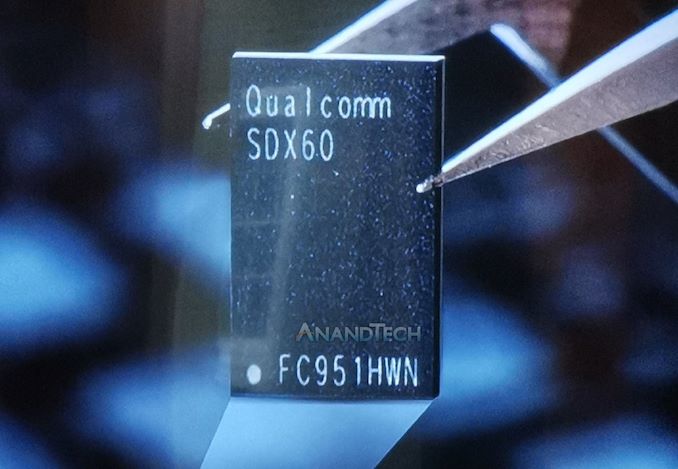
To date Qualcomm has promoted two key standalone 5G modems for widespread adoption: the Snapdragon X50 and the Snapdragon X55. Today the company is disclosing details on its upcoming 3rd generation 5G modem design, the Snapdragon X60, which is being promoted as the premium offering for smartphones, industrial, and commercial designs that require a discrete 5G modem. Key features of this modem include the fact that it is built on a 5nm process, supports carrier aggregation between Sub-6 and mmWave, and offers up to 7.5 Gbps download speeds.
The fact that Qualcomm is outright saying that their modem is going to be built on 5nm at this point of the game is very interesting, especially given TSMC’s recent disclosures on the capability of its 5nm process and its current timeline of development.
With the Snapdragon X60, Qualcomm is promoting support for more features of 5G, such as carrier aggregation between Sub-6 GHz bands in FDD/TDD (similar to LTE carrier aggregation), and support for simultaneous carrier aggregation between Sub-6 GHz and mmWave 5G bands. This leads to big jumps in peak bandwidth support, with Qualcomm listing up to 7.5 Gbps download over mmWave, 3 Gbps upload, and up to 5 Gbps download over Sub-6 GHz.
These peak speeds with the X60 modem is going to be achieved through new mmWave antenna modules. For the X50/X55, Qualcomm introduced its QTM525 module for mmWave, in a slim packaging to help enable the technology. Despite the sleek stature, the X50/X55 modems supported four of these modules, and Qualcomm recommended a minimum of three – the replacement of which did require these devices to be of a specific minimum thickness to ensure complete coverage. The new QTM535 module is promoted to be thinner, reducing that requirement.
Unfortunately the diagram showed by Qualcomm of the new module (as they didn’t have a physical one to show us) was not to scale, so no real conclusions could be drawn to the old module. Qualcomm also stated that they were not discussing dimensions at this time, despite the fact that the QTM525 launch was all about the dimensions. The new module can support 26 GHz, 28 GHz, and 39 GHz, enabling wider support. Qualcomm is going to keep its recommendation to vendors to use at least 3 in a connected device.
Alongside the modem and the mmWave antenna, Qualcomm is also offering the full RF front end for Sub-6 GHz. Qualcomm was proud to promote last year at its Tech Summit that out of the 150 devices that were using X50/X55 modems, all of them were using Qualcomm’s RF front-end solution. The X60 will similarly be a full stack offering.
Rollout of Qualcomm’s 5G modems has been a varied affair, with the time between the initial announcement of the first generation X50 and it actually launching into consumer devices being around two years. The process was sped up with X55, with a quicker time to market and eventually widespread deployment for consumer devices through the end of 2019 and likely for all of 2020. There was no doubt that Qualcomm was going announce its next generation design at some point, and with X55 in full swing, that time would appear to be now. When asked regarding timeframe of the X60, Qualcomm stated that they’re not sticking to any timeframe, with a spokesperson saying ‘these things go through revisions’. It is worth noting that for 5nm, TSMC has not yet entered high-volume manufacturing on this node yet (it will do soon, but yields are still low according to the ISSCC 2019 disclosure in December), and Samsung is further behind. So the exact timeframe for X60 rollout maybe sometime in 2021 at our best guess. Qualcomm has an annual Tech Summit in December, so we might see some of the first X60 reference designs at that event, likely with early silicon or the first batches of production silicon.
With MWC now cancelled, we might expect to see updates to the Snapdragon X60 news later in the year, perhaps at IFA in late August, or at Qualcomm’s own 5G analyst event. Then there’s always the Tech Summit in December.


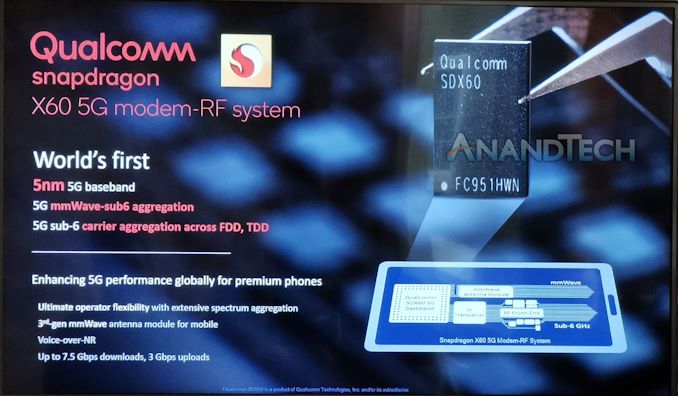
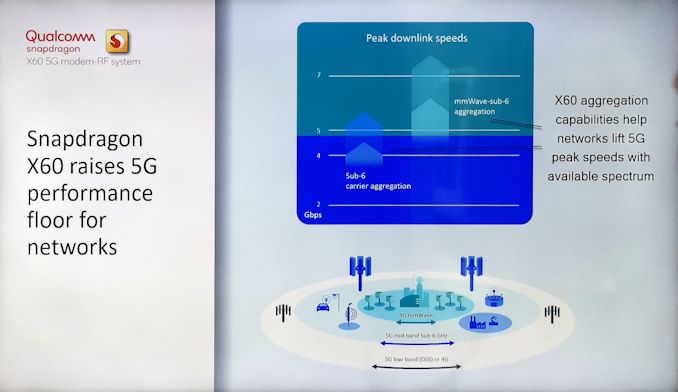
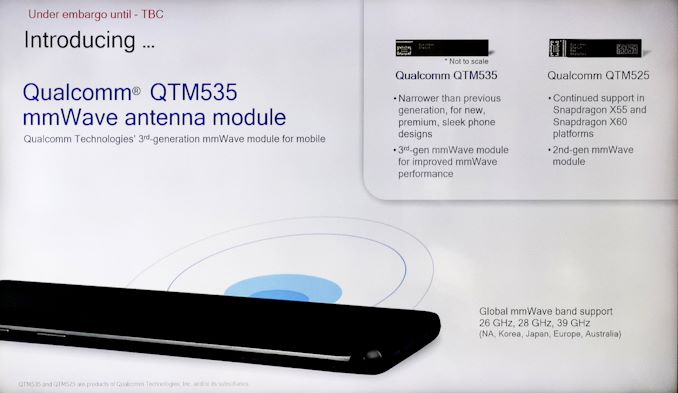
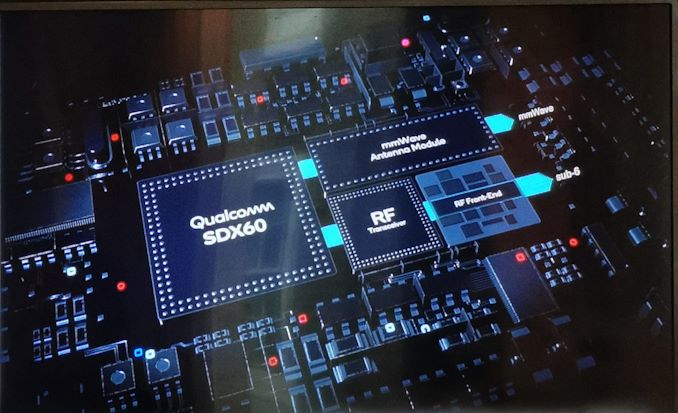
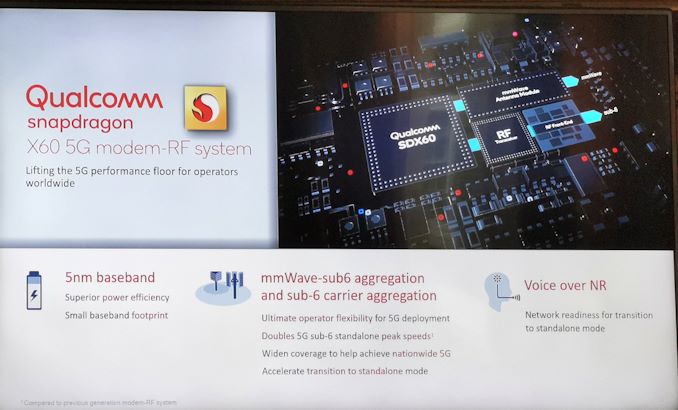








50 Comments
View All Comments
SydneyBlue120d - Wednesday, February 19, 2020 - link
I wonder when they will start removing 2G and 3G connectivity from modems, I bet Apple will be the first one...AndrewPhilips - Thursday, February 20, 2020 - link
What happens when you enter an area of weak coverage. You get no data? I don't think they will remove it.peevee - Friday, February 21, 2020 - link
2G pretty much does not exist anywhere anyway, it was removed to free frequency ranges. The same will happen to 3G very soon. It is not like the old protocols provide better ranges with their old and weak error correction algorithms. Low frequencies provide better ranges (at the same power), like T-Mobile's 600MHz.jhh - Tuesday, February 25, 2020 - link
The only reason the carriers still offer 2G or 3G is because of long-duration contracts to support it. For example, cars with built-in 2G/3G telemetry are not getting a 4G modem upgrade, and resale/off-lease values would drop if those features no longer worked. There are also shipping container tracking devices, and little desire to do a wholesale replacement just because they are still 2G devices. Verizon's plan for CDMA is currently planned to end at the end of 2020, deferred from the original date of end of 2019. At that point they will only support 4G or 5G voice, but it will still take time to remove all of their network equipment used for 2G/3G. I expect much of the equipment on towers to remain until there is a need for a tower climb, such as to install 5G equipment. They are likely to be disabled, so existing 4G or 5G equipment on the tower can reuse the same frequencies. The first thing to go will be paying maintenance fees to network equipment suppliers.Diogene7 - Friday, March 6, 2020 - link
I am no expert but, I would think there is less and less reasons to have a 2G modem in rich developed countries, but I am wondering about most under-develop countries in Africa...If you would happen to travel there with a smartphone that doesn’t support 2G network, you would not have any coverage...
So it could maybe happen, but maybe more between 2025 / 2030 timeframe or even later...
open4g - Thursday, February 20, 2020 - link
It may be years before handset mfgs. can fully integrate mmWave into mobile phone modems. mmWave makes sense when using wide channels to achieve hybri fiber-cable equivalent broadband speeds. The problem stems from higher power for transmission at the abobe 6 GHz frequenices. That is needed to process 100s of megahertz aggregate bandwidth signals. Similar to fiber-cable modems, high bandwidth consumes more power. The use of Qualcomm's advanced power saving technologies and 5 nm design rules helps to reduce the power, however, it is up to several times higher than current sub 3 GHz 4G. That higher power budget still does put mmWave close to being on par for range and building penetration, That is a reason why sub 6 GHz and mmWave carrier aggregation will be very important - to reduce average power usage so that battery life suffers less.mmWave can be usefull whenevcer a device is line powered. It can be used in mmWave to sub 6 GHz relay type 5G gNB netowrk node devices that are line powered and have high-gain or MIMO array antennas to extend the range and throughput over what can normally be achieved. These gNB can then connect to users via either 4G, 5G, WiFi or wired USB or Ethernet/GigE. The multi Gb aggregate speeds can replace fiber optic and cable so long as the relability is achieved including redundant pathways,
The usefullness of mmWave for fully mobile devices remains questionable IMO. This new modem will help but won't do magic to turn short-range coverage on its head.
Manofwind - Saturday, February 22, 2020 - link
Still it's not integrated into CPU.QuickTechSolution - Saturday, February 29, 2020 - link
This Article is Really Fantastic And Thanks For Sharing The Valuable Post..Issues With Quicken Software Dial Or Visit <a href="http://intuittechsupportcenter.us/">Quicke... Repair Services</a> Get Instant Help and Support from Quicken Certified Experts.You Do Not Want To Get Hold Of The Quicken Support Online Or Be Looking For Opening Hours For Quicken Support Team.<a href="http://intuittechsupportcenter.us/">Quicke... Customer Services</a>
<a href="http://intuittechsupportcenter.us/">Quicke... Customer Support</a>
<a href="http://intuittechsupportcenter.us/">Quicke... Technical Support</a>
<a href="http://intuittechsupportcenter.us/">Quicke... Technical Support Phone Number</a>
<a href="http://intuittechsupportcenter.us/">Quicke... Helpline Phone Number</a>
<a href="http://intuittechsupportcenter.us/">Quicke... Repair And Support Services</a>
QuickTechSolution - Saturday, February 29, 2020 - link
http://intuittechsupportcenter.us/">Quicken Support Number usahttp://intuittechsupportcenter.us/">Quicken Support Website
http://intuittechsupportcenter.us/">Quicken Support Help Number
http://intuittechsupportcenter.us/">Quicken Support Contact
http://intuittechsupportcenter.us/">Quicken Support Windows 10
http://intuittechsupportcenter.us/">Quicken Customer Support Number
sattajuhi - Thursday, March 12, 2020 - link
While making an email rundown to showcase your website on the web, never send messages without authorization. On the off chance that individuals get unsolicitated messages from your organization, they may disregard them, withdraw, or even report your organization to their email supplier as a spammer. Rather, inquire as to whether they need to get messages from you, and you will see increasingly intrigued supporters. <a href="http://www.playbazzar.xyz/">Play Bazaar</a> <a href="http://www.playbazzar.xyz/">Satta King</a>